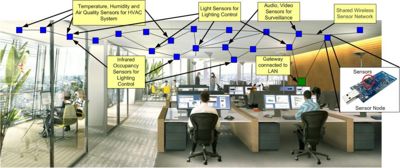Building Automation
Building automation was identified, a few years ago, as an effective way of achieving (a) efficient long-term building management and (b) considerable reductions in building energy costs. Some already installed building automation systems (BAS) have successfully achieved between 20% to 80% reductions in energy cost, increased occupant security/safety, increased occupant comfort and a reduction in building operations cost. Although several BAS have been installed so far, they have not yet achieved significant market penetration nor have they been utilized to their full potential. This is due to the existence of several unresolved issues like:
- interoperability between individual sub-systems like HVAC control, lighting control etc.
- use of wireless sensors that facilitate reduced installation/wiring cost
- increased information sharing between the various sub-systems
- integration with installed IT enterprise networks
- better application modeling and deployment toolkits
- increased system reliability
- better algorithms and optimization techniques
- real time monitoring and analysis
We try to address some of these issues by exploring the feasibility of using WSNs for building automation. The use of wireless sensor networks for building automation enables high-density sensing and control at lower operational costs and could therefore enable more efficient building management. The figure, above, shows an example of a WSN deployment for building automation.
Related Work
Utility-based Multi-Application Deployment Environment
Sensors
Applications
* Building access controls * HVAC controls * Lighting controllers * Thermostat * Lifts / Elevators * Escalators * Remote alarm triggering * Water Management * Electrical blinds
Resources
- NIST Project, Development of testbed for wireless sensor network use in buildings
- DOE report, Advanced Sensors and Controls for Building Applications: Market Assessment and Potential R&D Pathways
- Sensor Networks for Building Automation: Energy Efficiency
- Interesting List of Data Sources
- Österlind, Fredrik and Pramsten, Erik and Roberthson, Daniel and Eriksson, Joakim and Finne, Niclas and Voigt, Thiemo (2007) Integrating Building Automation Systems and Wireless Sensor Networks. In: 12th IEEE Conference on Emerging Technologies and Factory Automation, 25-28 September 2007, Patras, Greece. Tech-Report
- Christian Reinisch, Wolfgang Kastner, Georg Neugschwandtner, Wolfgang Granzer Wireless Technologies in Home and Building Automation, INDIN'07.
- Wireless Communication in KNX/EIB
- Wireless Sensor Networks for Applications In and Around Buildings
- ETH Building Automation Project
- Millennial Net MeshScape
- Suet-Fei Li, Vlado Handziski, Andreas Köpke, Martin Kubisch, Adam Wolisz (TU Berlin) A Wireless Sensor Network Testbed Supporting Controlled In-building Experiments, In Proc. of 12 Sensor Kongress, May 2005.
- Here is an interesting whitepaper by Echelon Corporation regarding their evaluation of using RF technology for building automation. The basic conclusion of the paper is that RF is not ready for prime time. The paper was released in 2005. More interesting Echelon papers here.
Echelon recently completed a year-long investigation of these technologies, and our findings were very different than we expected. We expected to test high-performance, highly reliable twisted pair replacements, but found just the opposite: the new RF technologies offered very poor robustness against sources of interference, very limited distance operation, mediocre battery performance, and in one case, response times slower than sneaker net.
- Ira Goldschmidt. "The Development Of BACnet" in the Strategic Planning for Energy and the Environment, Fall'98, Association of Energy Engineers.
- Z-Wave - This is a proprietary wireless communication interface that is nearly ubiquitous among light control manufacturers including Cooper, GE, Intermatic, and Leviton. It is in direct competition with ZigBee, an open standard that is built on top of IEEE 802.15.4.
- Pacific Northwest National Laboratory
- Converging Redundant Sensor Network Information for Improved Building Control
- Echelon Building Automation White Papers
- A System Architecture for Wireless Building Automation
- Increasing Capacity in Wireless Sensor Networks
- Vipul Singhvi and Andreas Krause and Carlos Guestrin and James H. Garrett, Jr. and H. Scott Matthews, Intelligent light control using sensor networks, SenSys'05
- Wireless Sensor Solutions for Home and Building Automation
- W. Steven Conner, John Heidemann, Lakshman Krishnamurthy, Xi Wang, Mark Yarvis, Workplace Applications of Sensor Networks, USC/ISI Technical Report ISI-TR-2004-591
- Siemens APOGEE® Wireless building automation solutions
- Thomas Haenselmann, Thomas King, Marcel Busse, Wolfgang Effelsberg, and Markus Fuchs, Scriptable Sensor Network Based Home-Automation
- W. Kastner, G. Neugschwandtner, S. Soucek, and H. M. Newman. Communication systems for building automation and control. Proceedings of the IEEE, 93(6):1178–1203, June 2005.
- Wireless Building Automation
Companies
- Dust Networks
- Echelon
- Ember
- Gridlogix
- Honeywell
- Johnson Controls
- MeshNetics
- Millennial Net
- Richards-Zeta
- Sensinode
- Siemens
- Spinwave Systems
News Articles
- Ember launches professional-grade sensor network software
- Thinking inside the box: Buildings get a brain
- MeshNetics Wins Industry Honours for its ZigBee™ Solution in Building Automation
- Wireless Sensor Networks
- New Standard in Wireless Sensors for the Building Automation Market
People
This work is being conducted by PhD students Sangeeta Bhattacharya and Chien-Liang Fok, under the guidance of Dr. Chenyang Lu and Dr. Gruia-Catalin Roman.
